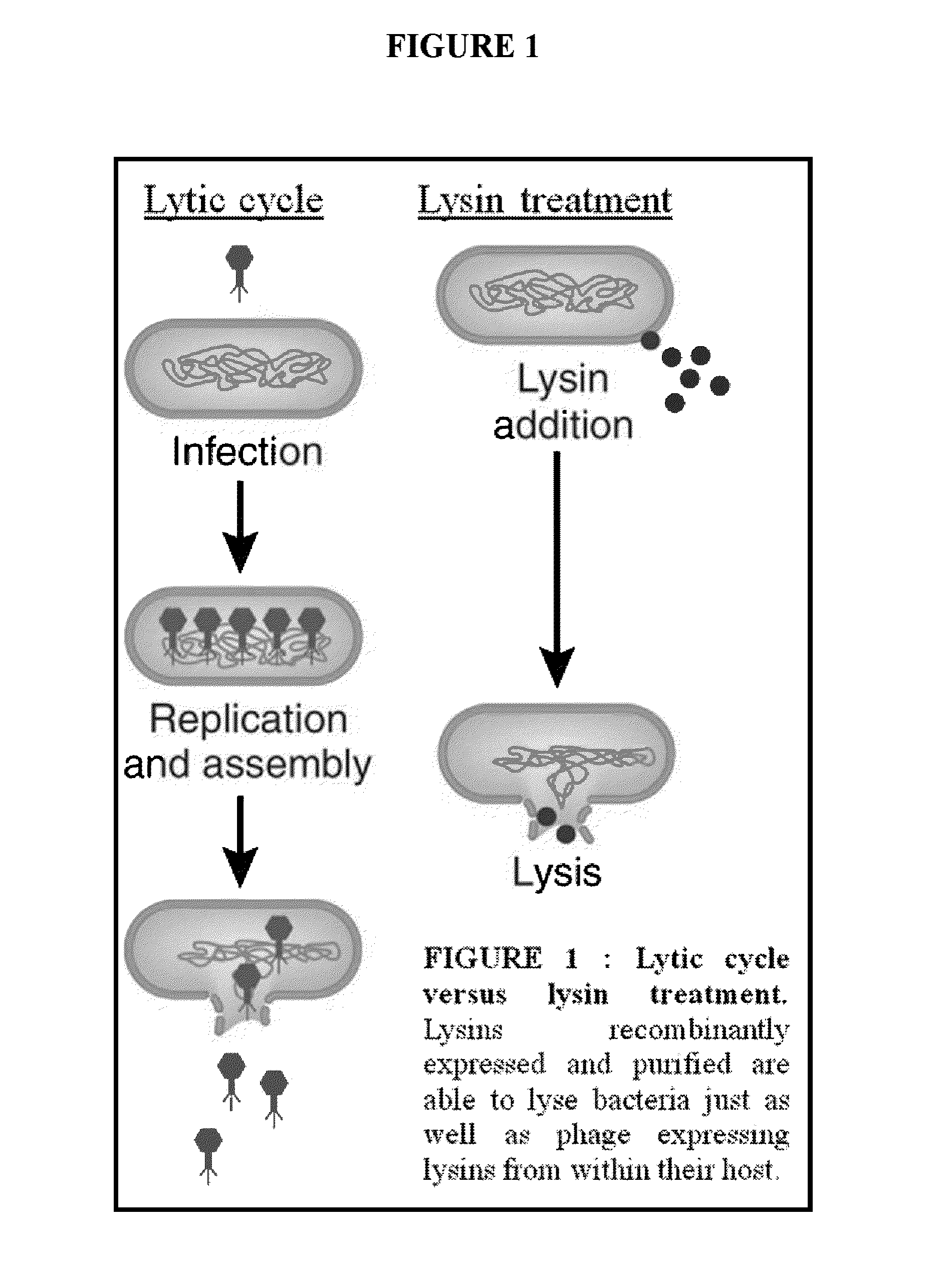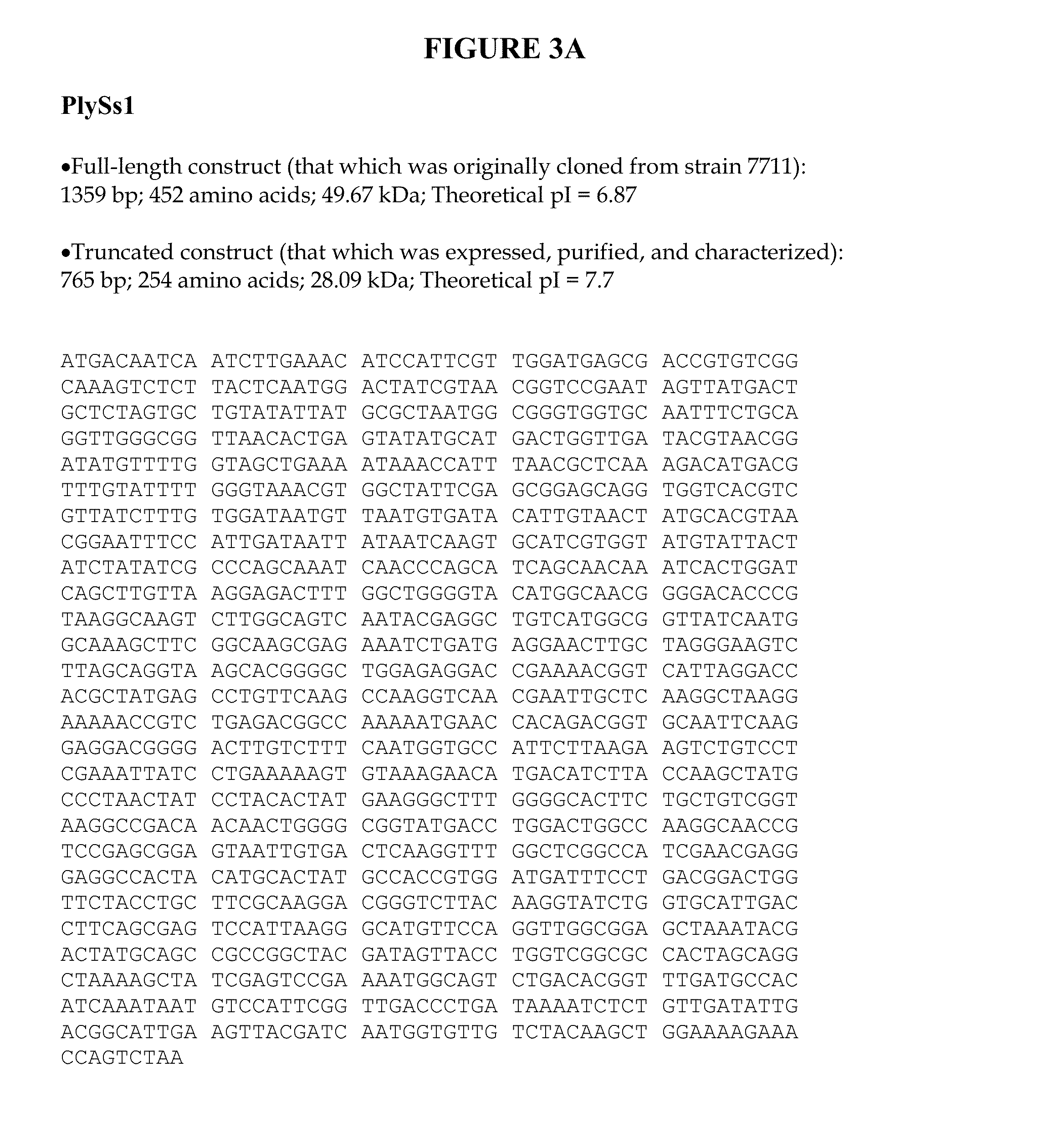Streptococcus bacteriophage lysins for detection and treatment of gram positive bacteria
a technology of lysins and bacteriophage, which is applied in the direction of antibacterial agents, peptide/protein ingredients, drug compositions, etc., can solve the problems of penicillin and cephalosporins, many antibiotics that cannot penetrate mucus linings easily, and drug resistant bacteria
- Summary
- Abstract
- Description
- Claims
- Application Information
AI Technical Summary
Benefits of technology
Problems solved by technology
Method used
Image
Examples
example 1
Cloning and Characterization of Phage Lysins from S. suis
[0250]Streptococcus suis is a Gram-positive pathogen that infects pigs worldwide. Reports of zoonotic transmission from pigs to humans are increasing (Sriskandan S. et al (2006) PLoS Medicine 3(5):585-567). S. suis may develop a consistent presence in human populations in years to come. Humans and pigs have been treated with penicillin or gentamicin, but S. suis isolates resistant to these antibiotics exist (Cantin, M. et al (1992) J Vet Diagnostic Investig 4:170-174).
[0251]We purified and characterized two phage lysins from strains of S. suis (PlySs1 and PlySs2) and confirmed their in vitro activity against various S. suis strains. In addition, the S. suis lysin, particularly PlySs2 lysin, was shown in vitro to kill various other and distinct strains of Streptococcus, including Group B strep. The PlySs2 lysin also is effective in killing numerous other bacteria, including other pathogenic and clinically significant bacteria,...
example 2
In Vitro Testing of Lysin Specific Activity
PlySs2 Activity
[0271]To determine PlySs2 lysin activity against different cell types, 5 μL of 1.6 μg / μL (8 μg) of PlySs2 was added in a microtiter well to 245 μL of cells (suspended in 15 mM Na3PO4, pH 8.0). In a corresponding well as control, 5 μL dd H2O was added to 245 μL of cells. Readings (OD600) were taken for each well in a spectrophotometer every minute over an hour. The OD density indicates the amount of bacterial cell growth in the microtiter well.
[0272]This activity test was first determined for the pathogenic S. suis strain 7997 with various concentrations of PlySs2 (FIG. 15A). Specific activity of purified PlySs2 lysin was also assessed in vitro against S. suis strain S735 (FIG. 15B). This test was then performed using 32 ug / mL PlySs2 to determine PlySs2 activity against other species of bacteria (it was found that based on lytic assay this was a good concentration for killing studies in vitro against other organisms) (FIG. 16A...
example 3
CFU Killing Assay
[0282]The specific killing and drop in colony forming units (CFU's) of S. suis S735 and 7997 was determined when exposed to 32 ug / mL PlySs2 for 60 minutes in 15 mM PB, pH 8.0 (FIG. 22).
PUM
| Property | Measurement | Unit |
|---|---|---|
| thick | aaaaa | aaaaa |
| pH | aaaaa | aaaaa |
| concentrations | aaaaa | aaaaa |
Abstract
Description
Claims
Application Information
 Login to View More
Login to View More - R&D
- Intellectual Property
- Life Sciences
- Materials
- Tech Scout
- Unparalleled Data Quality
- Higher Quality Content
- 60% Fewer Hallucinations
Browse by: Latest US Patents, China's latest patents, Technical Efficacy Thesaurus, Application Domain, Technology Topic, Popular Technical Reports.
© 2025 PatSnap. All rights reserved.Legal|Privacy policy|Modern Slavery Act Transparency Statement|Sitemap|About US| Contact US: help@patsnap.com



